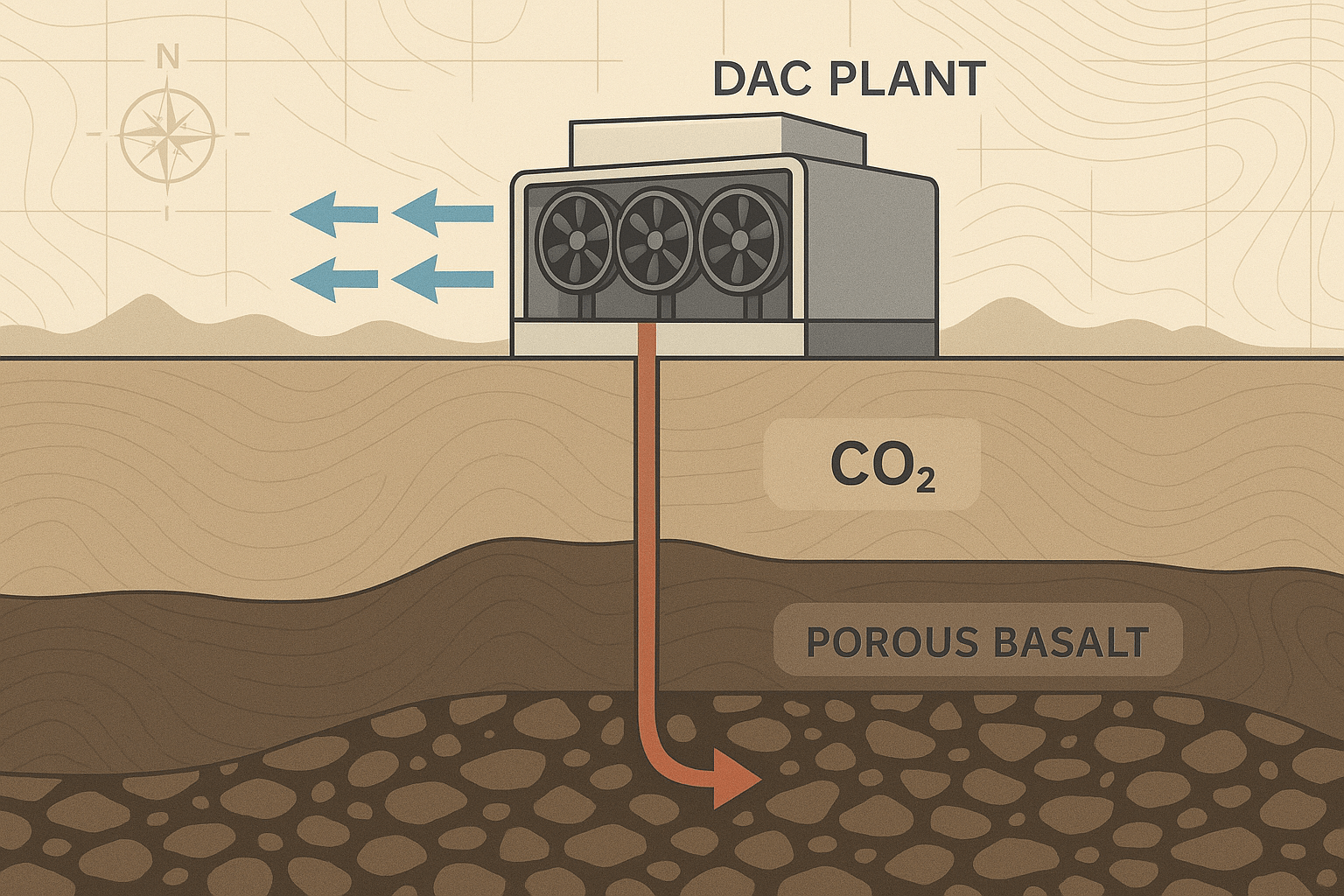The geography of this emerging industry is far from random. The decision to build a multimillion-dollar DAC plant in a specific location is a high-stakes calculation, a careful overlay of maps detailing geology, energy grids, infrastructure, and even political will. The result is a fascinating new world map where climate action is literally taking root in the ground.
The Twin Pillars of DAC Geography: Energy and Geology
To understand where these air-scrubbing facilities are being built, you first need to understand their two fundamental needs. Direct Air Capture technology, which pulls legacy CO₂ directly from the ambient atmosphere, is a two-part process: capture and storage. Each part has its own demanding geographic requirements.
- The Capture – An Thirst for Energy: Separating diffuse CO₂ molecules from the air is incredibly energy-intensive. To be a net positive for the climate, this energy must be cheap, abundant, and, crucially, carbon-free. This immediately narrows the search to regions blessed with powerful renewable resources, whether it’s the sun-scorched deserts of the American Southwest, the wind-whipped coasts of the North Sea, or the geothermal vents of a volcanic island.
- The Storage – A Permanent Geological Home: Once captured, the CO₂ can’t just be released. It must be permanently sequestered underground. This is where physical geography becomes paramount. Companies are hunting for specific geological formations capable of locking away carbon for millennia.
These twin pillars—clean energy and secure storage—are the primary drivers creating the hotspots in the new DAC atlas.
Mapping the Global Air-Scrubbing Hotspots
So, where are these unique geographical conditions converging? A few key regions are emerging as the world’s first DAC hubs, each leveraging a distinct local advantage.
Iceland: The Volcanic Pioneer
Perhaps the most iconic DAC location today is Iceland. Here, the Swiss company Climeworks has built its Orca and newer, larger Mammoth plants. Iceland’s geography offers a perfect, almost purpose-built combination of factors.
First, it sits atop the Mid-Atlantic Ridge, a hotbed of volcanic and geothermal activity. This provides a constant supply of clean, renewable geothermal energy that not only powers the DAC machines but also provides the low-grade heat needed in the capture process. Second, the entire island is composed of young, porous basaltic rock. When CO₂ is mixed with water and injected into this basalt, a process of natural mineralization occurs. The CO₂ reacts with minerals like calcium and magnesium in the rock, turning into solid carbonate minerals—literally, turning carbon emissions back into stone within a few years. It’s one of the most secure forms of carbon storage known.
The U.S. Permian Basin (Texas): From Oil Fields to Carbon Sinks
Head thousands of miles southwest to the arid plains of West Texas, and you’ll find a completely different, yet equally compelling, geographical logic. Here, in the heart of the U.S. oil industry, Occidental Petroleum (Oxy) is building Stratos, poised to be the world’s largest DAC facility.
The geography of the Permian Basin is a story of transition. Its advantages include:
- Geological Storage: Instead of basalt, this region sits on vast, deep saline aquifers. These are porous rock layers saturated with unusable, salty water, which have the capacity to hold immense volumes of compressed CO₂ for geologic time.
- Energy Potential: West Texas is a renewable energy powerhouse, with some of the best solar and wind resources in the United States, providing the necessary clean power.
- Human Geography: Decades of oil and gas exploration mean the subsurface geology is incredibly well-understood. More importantly, there’s a wealth of existing infrastructure—pipelines, drilling expertise, and a skilled workforce—that can be repurposed for carbon management. Bolstered by significant financial incentives from the U.S. government’s Inflation Reduction Act, Texas has become the epicenter of DAC development in North America.
Oman: Sun, Sand, and Reactive Stone
The Middle East, a region defined by its fossil fuel wealth, is also entering the race. In Oman, the unique local geology is the main attraction. The Hajar Mountains contain some of the world’s largest exposed sections of peridotite, a rock type that, like basalt, reacts naturally with CO₂ to form solid minerals.
Combined with Oman’s world-class solar potential and its strategic goal of diversifying its economy away from oil, the region presents a powerful case for DAC investment. Startups are already working on projects to leverage this unique combination of sun and stone, proving that the future of energy isn’t limited to one type of geology.
The Human Geography of the Geotechnical Race
Beyond rocks and renewables, human geography plays a critical role. The “where” of DAC is also shaped by policy, economics, and infrastructure.
Government incentives, like the 45Q tax credit in the United States, can single-handedly make a region a prime target for development by making the high cost of DAC economically viable. The presence of ports, roads, and a workforce familiar with large-scale industrial projects gives established energy hubs a significant head start. In places like Wyoming, North Dakota, and Louisiana, state governments are actively mapping their geological storage potential and creating regulatory frameworks to attract DAC projects, hoping to become the next carbon management hubs.
As this new geotechnical race accelerates, the world map is being redrawn. The most valuable locations of the 21st century may not be those with the most oil underground, but those with the perfect combination of clean energy above ground and secure storage deep below. This emerging geography of air-scrubbing is a tangible, physical manifestation of our global effort to rebalance the climate, one strategically chosen location at a time.
